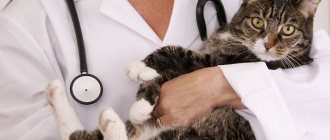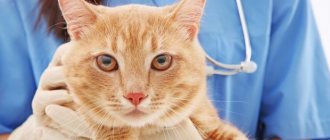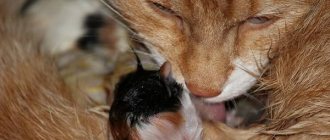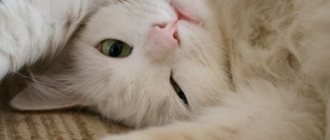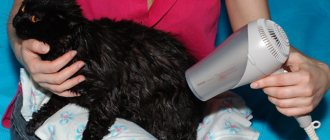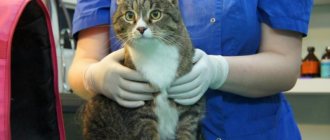12582Administration
Many owners of furry beauties choose to sterilize cats, since the operation is quite simple and with proper care for the animal, the healing process proceeds safely, without causing serious consequences.
An important role is played by a blanket that covers the cat's seam, protecting against the entry of germs and licking of the wound. It is necessary to know when to remove the blanket from a cat after sterilization, and try not to violate the deadlines, since the further well-being of the pet directly depends on this.
When can you remove the blanket?
A bandage (blanket) tied on the back is used to protect the sutures on the abdomen placed in the clinic during surgery.
The healing period of the suture is extremely important for the future health of the cat.
Sometimes it is possible to remove the blanket from a cat after sterilization already on the second day after the operation, but if emergency situations arise, the period of wearing the bandage can increase to 10 days or more.
The main problem when wearing a protective device can be considered that the tailed pet protests with all his might against putting it on , tries to get rid of it, seems very unhappy, which causes the owner a natural desire to make the cat’s life easier.
But there are a number of nuances that affect the period of wearing the bandage.
Prevention of complications after cat sterilization
Spaying or neutering a cat is an abdominal operation during which the uterus and ovaries are removed. Any abdominal surgery involves the use of anesthesia and maintenance therapy after the intervention.
If the cat was healthy at the time of surgery and the intervention itself went without complications, postoperative care is minimal. Immediately after the operation, the cat is given a broad-spectrum antibiotic, an anesthetic, and some veterinarians additionally inject immunostimulants.
If the cat was not intentionally taken out of anesthesia, it should sleep for at least 12–20 hours. If for some reason the animal had to be taken out of anesthesia, it is prescribed additional injections of an anesthetic drug, and sometimes sedatives.
Since surgical intervention involves opening the abdominal cavity and penetrating into it, albeit sterile, foreign objects, most veterinarians prefer to play it safe.
After sterilization, the cat is usually given a 3-7 day course of broad-spectrum antibiotics. The owner is expected to administer the injections at home. The drugs are most often administered intramuscularly.
Contrary to the logic of most owners, the seam does not need to be treated after surgery. For normal, rapid healing of the seam, it must remain dry.
In order to prevent damage to the seam, its spillage or infection, it is recommended that the cat wear a protective blanket or Elizabethan collar
What to do if the suture bleeds after sterilization
During the day after the operation, ichor may be released from the cat's suture - this is normal. If the cat was sterilized while pregnant or during the operation it was discovered that the animal has ailments of the reproductive system, drainage may be left in the suture.
Drainage is a silicone tube or hole through which ichor, pus or any other liquids should come out.
What to do if you find that your stitch is bleeding? Do not panic under any circumstances, assess the situation and call the veterinarian. Immediately after sterilization, blood loss is up to 5 ml and is considered normal. Call a veterinarian at home if scarlet blood continues to flow from the stitch. A slight discharge of almost coagulated, brown blood or ichor mixed with blood is considered acceptable.
If postoperative bleeding occurs, hemostatic drugs are usually prescribed. Medicines affect the composition of the blood, saturating it with platelets and making it thicker.
During hemostatic therapy, it is prohibited to use most painkillers because they thin the blood.
Non-steroidal anti-inflammatory drugs are usually used to relieve pain.
What affects the duration of wearing a blanket?
The number of days directly depends on the method in which the postoperative sutures were processed.
Types of processing:
- Using a protective spray. This method of treating a postoperative suture protects the wound from the development of inflammatory processes, accelerates the healing process, has a beneficial effect on overall well-being, and reduces the period of wearing protection to 7 days.
- Without using protective spray. In this case, we are talking about a time interval from a week to 10 days, it all depends on the condition of the animal and the speed of healing of the skin.
Be sure to read:
After sterilization, a cat sleeps a lot and is lethargic: normal or pathological, what consequences may occur after surgery
The protective bandage is made from natural fabrics (cotton), does not irritate the animal’s skin, does not allow the cat to lick the wound, protects against inflammation of the seam, but causes some discomfort to the pet.
Your furry pet may notice changes in behavior or gait, but as soon as the protection is removed, everything will be restored.
Important! Many owners independently decide when to remove the blanket after surgery, based on the fact that the cat is hampered by the protective bandage. If the bandage is removed without the advice of a veterinarian, it is necessary to constantly monitor the pet. You can use a special collar that will prevent the animal from licking the seam.
Do's, Don'ts and Don'ts
Need to:
- monitor the condition of the blanket (bandage) - cleanliness, integrity and general comfort;
- continue to treat the cat for blood-sucking parasites, monitor the condition of the ears and schedule anthelmintic. The body, weakened by surgical intervention, has poor resistance to internal and external parasites;
- monitor your diet to avoid the development of constipation, and also reduce food portions than before the operation. Enhanced feeding or voluntary feeding can trigger the development of obesity. Neutered cats should consume almost a quarter less food.
Can:
- carefully pick up the animal in your arms, picking it up under the front and hind legs, without putting pressure on the stomach;
- take him for short walks under supervision;
- water as much as the cat wants;
- feed with special food for sterilized cats.
It is forbidden:
- allow the cat to bask on warm radiators and heaters after surgery;
- pick up the cat in your arms for a month, picking it up only by the front paws;
- smear the seams with any alcohol-containing substances (iodine, brilliant green, chloramphenicol, etc.) - there is a high probability of burns;
- leave food in the morning for the whole day (especially in the summer). Food should be left out for 15-20 minutes in the morning and for the same amount in the evening to eliminate the possibility of overeating or poisoning from souring;
- remove the blanket until the stitches are completely healed;
- actively play with the cat and jump in the first two weeks.
Sterilization (castration) is not a complicated operation, the difficulty lies in the postoperative period. After surgery, you should definitely get recommendations from your veterinarian on how to care for your cat and strictly adhere to them. In any emergency situation, you must consult a specialist.
Author:
Grinchuk Ekaterina Andreevna veterinarian
When is it possible to remove the protective device early?
The protective bandage is made from natural fabrics (cotton) and does not irritate the animal’s skin
. Early removal is possible if:
- the surgical intervention was carried out using laparoscopy: in this case, the wound is so small that protection is not required;
- when performing sterilization, the surgeon used absorbable suture material and protective sprays to treat the wound;
- Four days after the operation, the cat has a normal body temperature, there is no bleeding, redness of the suture, or suppuration.
Important! When using suture material that requires further removal, you should not remove the bandage ahead of time, even if it causes discomfort to the animal.
After examining your pet, the doctor may recommend getting rid of the protective accessory ahead of schedule if:
- aggression is clearly expressed, the animal continuously tears off and gnaws the blanket;
- the animal is afraid to walk in a bandage;
- ulcerations appeared under the places where the tissue puts maximum pressure on the body;
- the bandage became very dirty due to eating and visiting the toilet.
Day three
We woke up in the morning, the blanket was lying somewhere, and Aliska was sitting there licking her wounds. I'm shocked! They grabbed this weightless miracle and with difficulty put on the blanket. Most likely it’s wrong, but today we’ll get an antibiotic injection, they’ll tell us. In general, I read in people’s reviews that you can put a nylon stocking on a cat after cutting it out, she definitely won’t take it off. I also saw on the Internet special collars for the neck, with them she will not be able to reach the seam.
I pushed her into the carrier with difficulty, she desperately struggled and meowed. We went for an injection, it’s strange that the doctor scheduled it for someone other than her shift. The nurse looked at the suture and said everything was fine. I treated it and then gave it an injection. We paid another 148 rubles for this.
I asked the nurse about the tights. She was indignant - these are synthetics, they don’t breathe, the cat will snort under them, and then she will have to treat them.
I also forgot to ask what kind of surgery it was, did they just cut out the uterus? Or along with the pipes?
Now it’s only the 23rd to go to the doctor to have the stitches removed, how will we survive the week and one day?
In the morning Aliska also had an appetite, but after the injection it disappeared again. And, in general, my health worsened. She again lay with her eyes open and did not eat anything. And the cat began to walk backwards.
Receipt for an antibiotic injection
Observation after removal of the bandage
After the bandage is removed, it is necessary to carefully monitor the cat's condition in the first days. The cat family is characterized by increased cleanliness, therefore, at first the animal will constantly lick the seam.
The owner must ensure that the cat does not chew the edges of the healed wound.
Be sure to read:
A cat has a lump on her stomach after sterilization: reasons for the appearance of ours and under the suture, what to do, prevention
Important points during inspection:
- monitor the integrity of the edges of the wound surface;
- control whether there is any discharge from the wound in the form of blood or lymph;
- inspect the seam for redness, inflammation, and the appearance of purulent discharge;
- check whether nodes or swellings have appeared along the edges of the wound surface.
Any of the identified anomalies is a reason for an unscheduled visit to the veterinarian.
Processing and removal of seams
The sterilization operation is carried out under anesthesia; the owner needs not only to properly remove the animal from this state (properly contain, feed, give water), but also take care of the cleanliness of the wound.
The procedure for treating sutures begins on the third day after sterilization
The procedure for treating sutures begins on the third day after sterilization, at intervals of 2 times a day.
Algorithm of actions:
- Calm the beast, remove the bandage.
- Use a cotton swab soaked in an antiseptic (without alcohol) to generously moisten the wound surface with gentle movements.
- Remove hairs and dried blood.
- Inspect for inflammatory processes.
- Put on a bandage.
Attention! In some cases, to speed up healing, cat owners apply iodine or brilliant green to the stitches. It is strictly not recommended to do this: the drugs dry out the edges of the wound, inhibit recovery processes, and can lead to chemical burns of the skin.
Some tips for caring for your cat after surgery
If the animal refuses to let its owner near, fights and breaks out, then you should:
- give the animal sedatives during the recovery period;
- do not show aggression or dissatisfaction with the behavior of the animal, talking affectionately and stroking it;
- carry out the treatment after swaddling the pet with a soft towel.
It is forbidden:
- use alcohol tinctures for processing;
- rub the surgical site;
- Thickly lubricate the seams with a healing agent;
- apply a tight bandage.
Proper care and the presence of blankets are the key to a speedy recovery.
